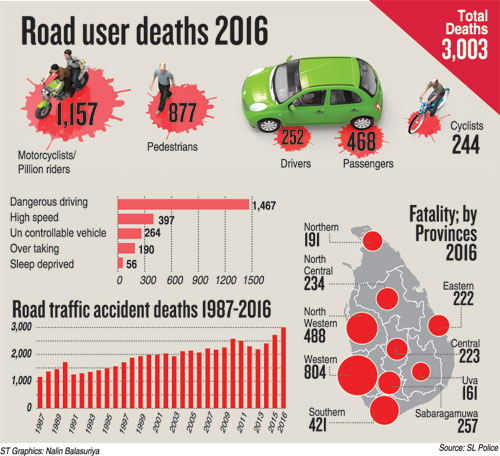News
Sleepy drivers dicing with death
 Exhausted drivers who nod off at the wheel have emerged as a significant danger on the roads of Sri Lanka, alongside speeding divers.
Exhausted drivers who nod off at the wheel have emerged as a significant danger on the roads of Sri Lanka, alongside speeding divers.
An academic says speeding and fatigue account for the majority of deadly injuries in road traffic accidents.
About 60 per cent of fatal and grievous injuries are caused by speed combined with fatigue, an expert on transport, Professor Amal Kumarage of the University of Moratuwa, said.
But overall, the vast majority of crashes occur because drivers have not yet developed the crucial skills they need, Police Traffic Chief, Deputy Inspector General of Police Palitha Fernando said.
He explains that working late hours, doing more than one job, work stress, family factors can badly affect driving.
He said driver training schools must be forced to include lessons on fatigue and driving while being drowsy.
“If the driver does not want to accept that he is sleepy, if he insists on continuing driving to complete the journey, however compelling the reasons, we can at least educate him on what he could do to overcome fatigue and drowsiness,’’ he suggested.
Billboards at entry, exit and midway points along all major roads and highways must be erected to alert the drivers on the danger of driving when they are tired, he said.
Professor Kumarage said passengers should also be alert to certain physical signs that may indicate the driver is exhausted.
Tired drivers take more risk, yawn frequently, are seen nodding, and blinking. They show no interest in carrying on a conversation with those in the vehicle.
He also noted measures that can help prevent crashes caused by sleepy drivers. “Changes to road design (eg, tactile road edges and divided highways), as well as education campaigns, may help reduce crash risk.’’
Long-term lack of sleep may not only cause immediate drowsiness at the wheel, but may affect a young driver’s judgment over time.
One in seven licensed drivers aged between 16 and 24 years admits having fallen asleep at least once while driving in the past year and that 10 per cent of all drivers say they’ve dozed off at the wheel, Prof Kumarage said.
Driving after just four to five hours of sleep is comparable to driving with a blood alcohol content at or above the legal limit, he said. The risks of driving after less than four hours sleep is much greater.
“Using a rest stop, drinking coffee, and playing the radio while driving have been shown to be significantly protective against crashes, at least in the short term,” consultant physician Dr. Shakya Peiris at the National Hospital Colombo said.
“Taking a 10 to 20-minute nap every couple of hours on a long drive has huge safety benefits in terms of your ability to drive without crashing,” he says. It’s also possible to catch up on missed sleep — to a point.
3,000 KILLED IN ROAD ACCIDENTS IN 2016
In the last year alone, more than 3,000 people were killed in more than 38,500 accidents – an increase of 871 from 2015. This toll includes dangerous driving (1,467), high speed (264), non-controllable vehicles (190) and careless driving (94).
In total, 3,001 deaths were reported last year. The Western Province tops the lists with 804 fatalities, followed by North Western (488), Southern (421), Sabaragamuwa (257),North Central (234), Central (223),Northern (191), Eastern (222) and Uva (161).
| 3,000 killed in road accidents in 2016 Last year alone, more than 3,000 people were killed in more than 38,500 accidents – an increase of 871 from 2015. This toll includes dangerous driving (1,467), high speed (264), non-controllable vehicles (190) and careless driving (94). In total, 3,001 deaths were reported last year. The Western Province tops the lists with 804 fatalities, followed by North Western (488), Southern (421), Sabaragamuwa (257),North Central (234), Central (223),Northern (191), Eastern (222) and Uva (161). |

